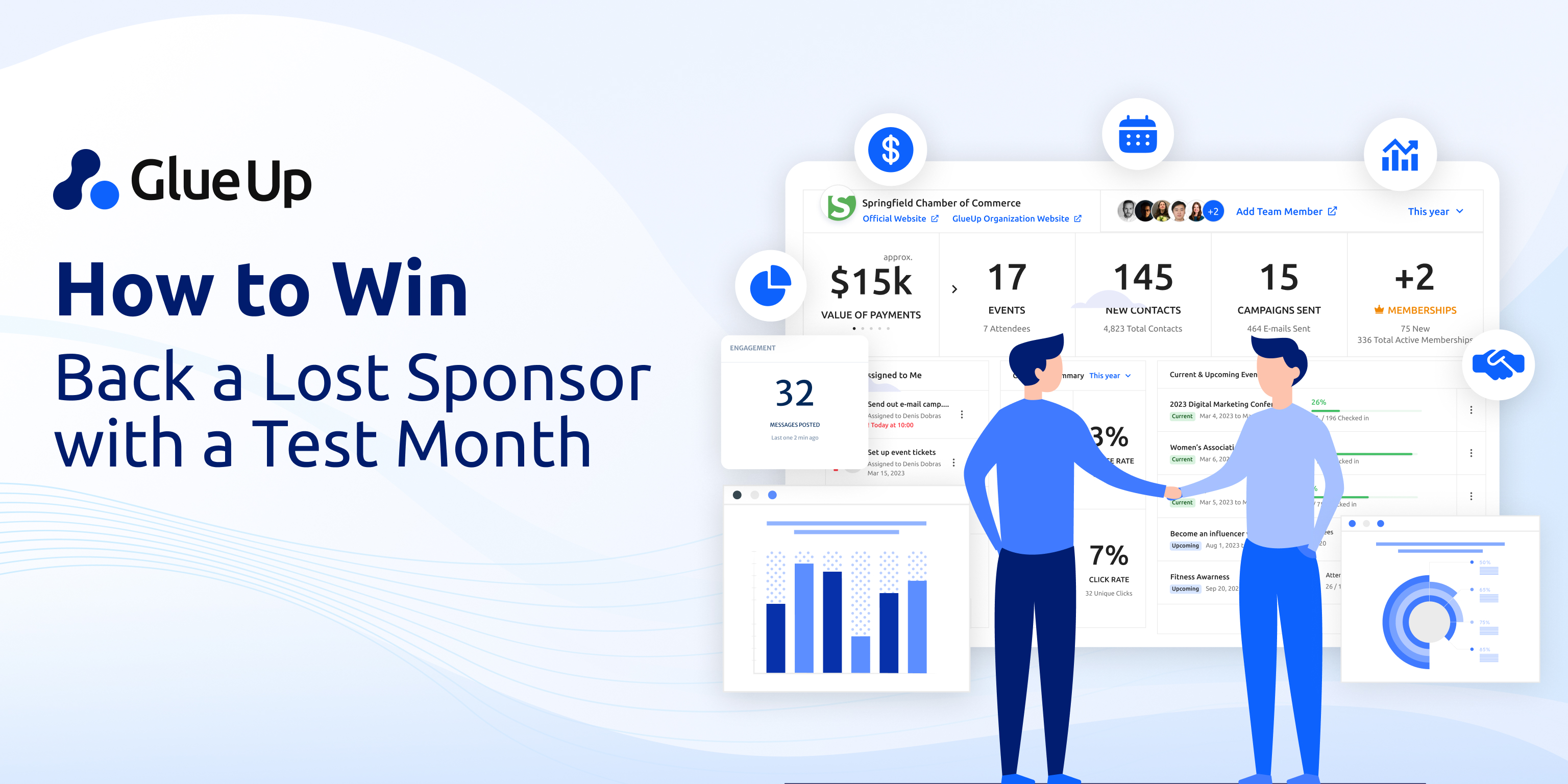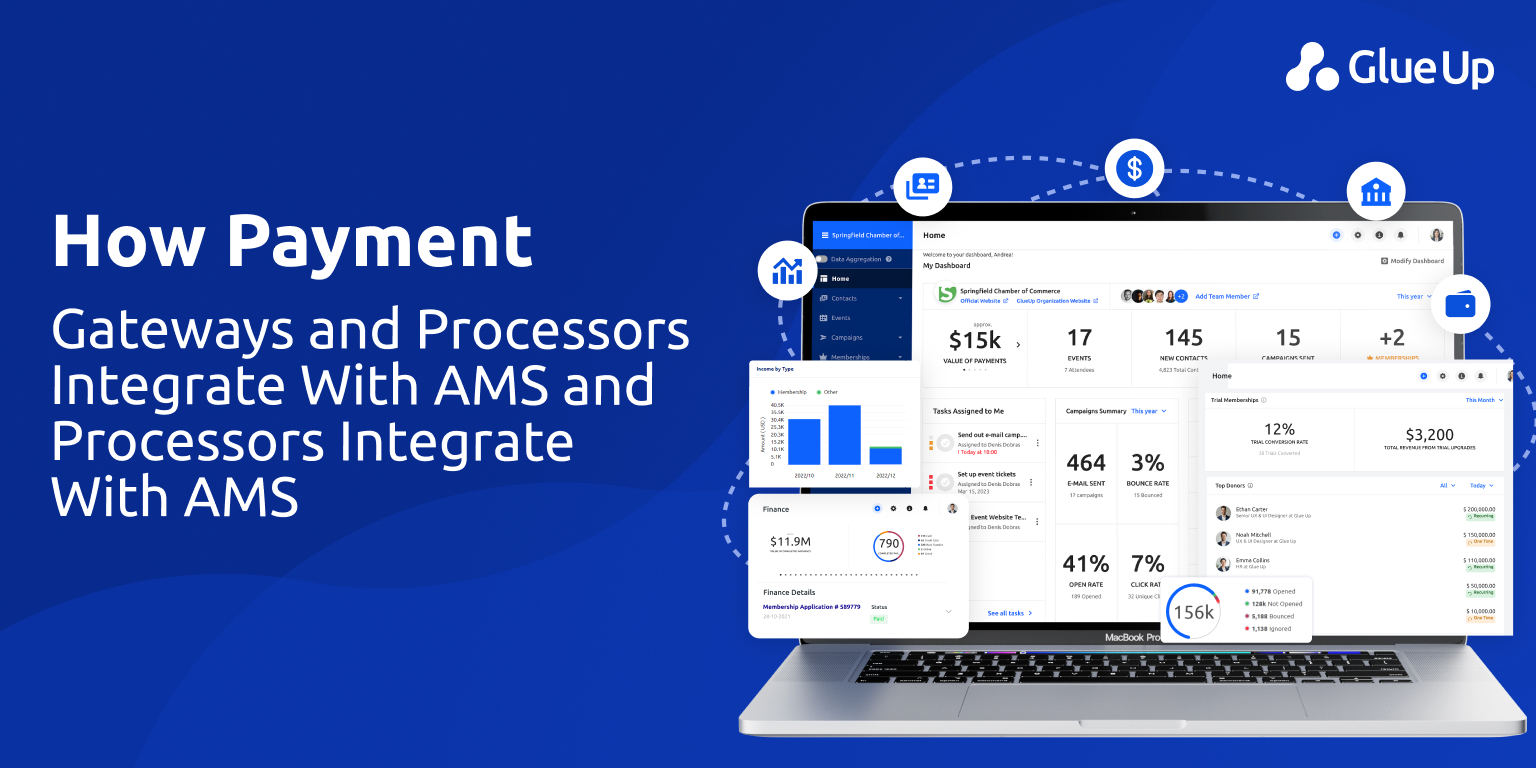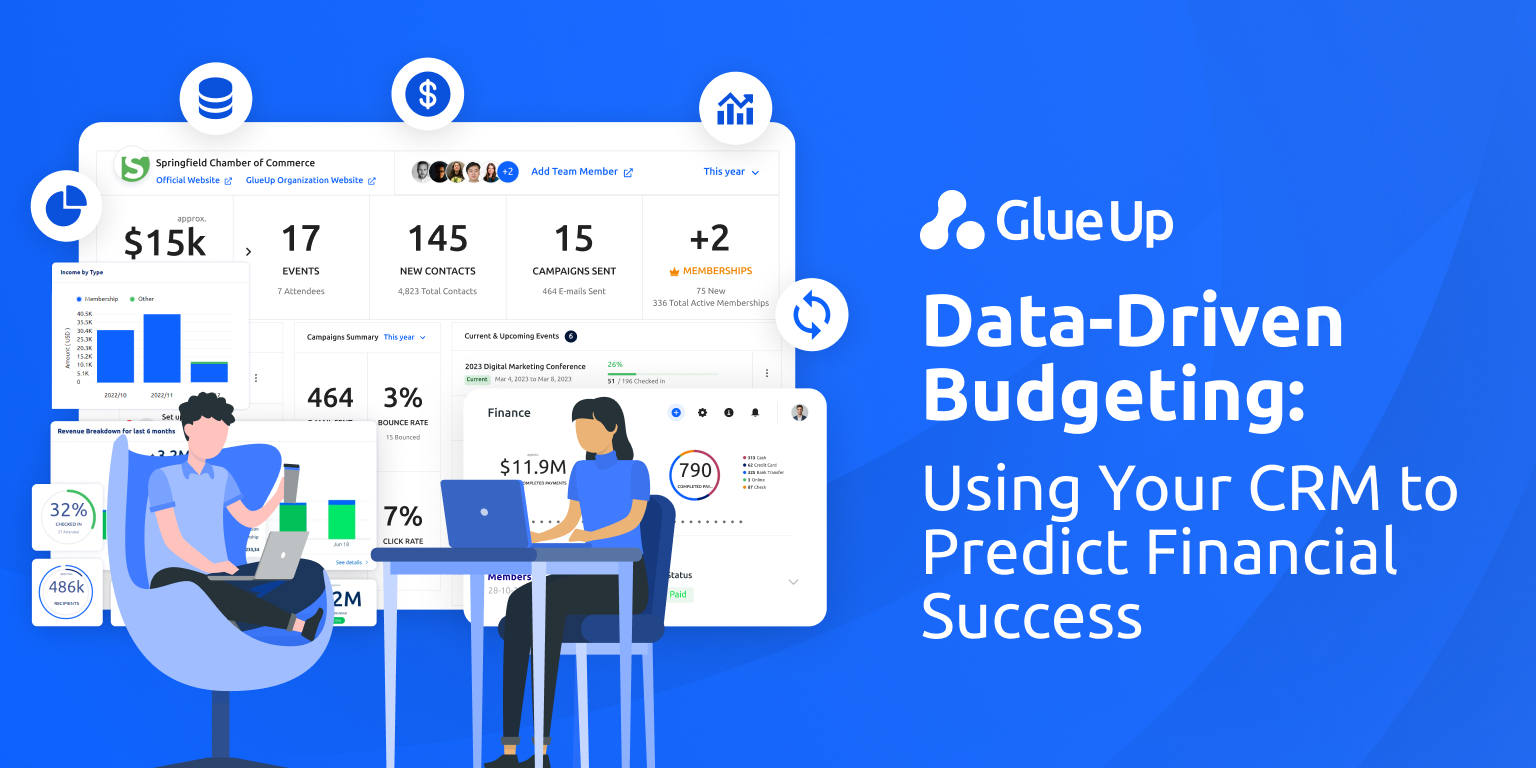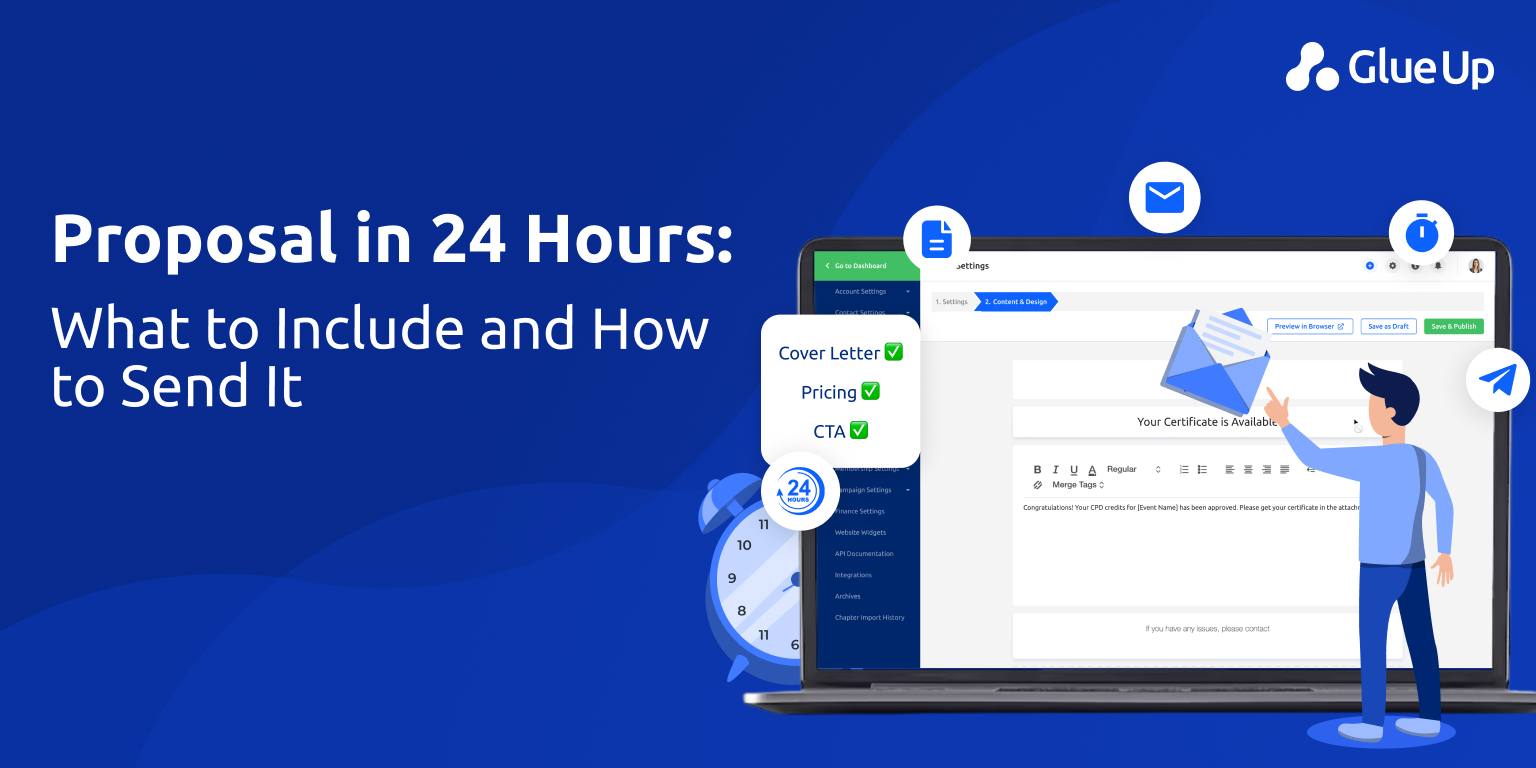
When you think of sponsor retention, you probably picture the renewal handshake at year-end, a familiar logo sliding into next year’s event catalogue, a long-term commitment quietly tucked into your budget. But what if the missed renewal, the one partner who quietly stepped away, is actually your best shot at a stronger, smarter sponsorship engine? At that moment of attrition lies an opportunity: to invite them back via a one-month “trial” sponsorship, recalibrate value, rebuild trust, and turn a lapsed partner into a loyal advocate.
In this article we’ll walk through why sponsor retention matters, why a short-term test month can shift the dynamic, how to design the offer (with pricing, deliverables, metrics), and how to turn that trial into a full-term programme. Our conversation is grounded in research, real-world association practice and the platform logic that Glue Up brings to sponsorship workflows. If you manage sponsorships for a chamber, association or non-profit, this is your roadmap for reclaiming value instead of writing it off.
Key Takeaways
A lapsed sponsor reveals a breakdown in perceived value, not an irreversible loss. Treat non-renewal as data, not defeat. The exit itself tells you what to fix: expectations, communication, or ROI clarity.
Instead of asking a lost sponsor for a full renewal, invite them to a structured 30-day test sponsorship. It lowers their risk, shows your improvements, and gives both sides measurable outcomes to evaluate before committing again.
During the test month, track metrics that matter: impressions, engagement, lead quality, brand visibility, and post-event ROI. When you can prove tangible results, trust rebuilds faster and renewal conversations become rational, not emotional.
Retention depends less on goodwill and more on operational consistency. Use formal processes: debriefs, defined deliverables, renewal checkpoints; to turn sponsor relationships into managed partnerships supported by clear data.
With Glue Up, associations can automate tracking, deliver real-time ROI reports, and centralize sponsor data, creating a continuous sponsor-retention loop that converts trial partners into multi-year sponsors.
Quick Reads
The Cost of Lost Sponsors, and What They Really Tell Us
Losing a sponsor is a signal. A partner who once believed in your mission, your audience and your value didn’t feel sufficiently rewarded to commit again. The cost of this vanishing partnership reverberates event budgets shrink, programmes get scaled back, internal morale softens. But more subtly, and more dangerously, is the message it sends to other sponsors: “If they left, maybe the value isn’t there.”
Research in the sponsorship literature backs this up. One study of nearly 500 corporate sponsors across six major North American sport leagues found that the probability of renewal is significantly lower when sponsorship is at a lower level or when brand–property fit is weak. Another practitioner article aimed at associations noted that while 91 % of sponsors say they are open to renewing, only about 65 % do when expectations aren’t met.
Sponsor retention is about ensuring that value was delivered, that relationships remained alive, and that the partner felt part of something rather than simply a logo on a stage. When you lose that sense of value or partnership, the renewal conversation becomes awkward at best, or silent at worst.
Which is why the one-month test offer becomes strategic. It says: we recognize the breakdown, we’re offering low risk, we’ll demonstrate value, then you decide. It flips the conversation from “Will you sponsor us again?” into “Let’s see how it works this time, together.”
Why a One-Month Test Sponsorship Matters
If you’ve managed sponsorships, you know the cycle: negotiation, contract, deliverables, execution, report, renewal. It often takes 6–12 months or more. When a sponsor leaves, the gap widens: the relationship goes cold, trust dims, memories fade. Asking for a full re-commitment right away feels like asking for a leap of faith, and many partners won’t take it.
A one-month trial changes that dynamic in three keyways:
Lower risk for the sponsor. They’re not committing a full year; they’re committing a short window with defined deliverables.
Proof of concept for you. You get a chance to show that you listened to their feedback, improved your offering, and are ready to deliver differently.
Data-driven renewal path. Instead of “will you renew?”, you ask “did we hit your success parameters this month?”, and base renewal on metrics.
From the perspective of sponsor retention, this is a powerful shift. You’re signaling, we value our relationship, not just your money. You’re giving them a chance to re-engage, check the value, and then decide. That matters.
For associations and chambers using a platform like Glue Up, this logic aligns well. You already use community posts, webinars, events, and measurement tools. Designing a one-month trial means you can plug a sponsor into your existing infrastructure, track their exposure, link to outcomes, and create a clear renewal decision.
Designing the Test Month: The Offer
Designing this trial offer is where you move from concept to execution. The goal is to create something strong enough to prove value but clear, contained and time bound.
Debrief With the Past Sponsor
Before you send the offer, have a short conversation or call with the lapsed sponsor. Questions to ask:
What were your expectations last time we partnered?
What did not go as you hoped?
If you were to test a new sponsorship now, what would success look like for your company?
Document their responses. Use them to craft the trial that aligns with their objectives. This step reinforces your commitment to the sponsor’s goals.
Offer Structure (Example)
Here’s a suggested structure for the one-month trial:
Community post: One dedicated post in your member network or in your online community (audience size, segment) featuring the sponsor’s message, logo, link, call-to-action.
Webinar role: One webinar for your members in that month. The sponsor receives: a mention at the beginning, a short 3-minute spotlight or panel contribution, logo on the session page, and access to the attendee list (where allowed).
Deliverables & timeline: Specify start and end dates (e.g., May 1 – May 31), exact deliverables (post distribution schedule, webinar date/time, pre-promotion, post-webinar follow-up).
ROI report: At the end of the month, you’ll deliver your standard ROI report: number of impressions (post views, click-throughs), engagement metrics (comments, likes), webinar registrations, live attendees, on-demand views, leads captured (opt-ins), brand-visibility tally (mentions in newsletters/recaps).
Trial price: Set a fair but attractive price.
Renewal decision: Clear statement that at the end of the trial you’ll meet and decide together whether to move to a full term, extend the trial or conclude.
Email Template You Can Use
Subject: Invitation: 30‐day sponsorship re-entry trial with [Association Name]
Hi [Sponsor Name],
I hope you’re doing well. We truly valued our previous partnership with [Sponsor Company] and have reflected on how to deliver even greater value for you this time. We’d like to invite you to a 30-day trial sponsorship with [Association Name]. Here’s what we propose:
• One dedicated community post to our [insert segment size] members in [industry] during the month of [Month]
• One slot in our [Month] webinar (date: [insert]) where you’ll have [mention/moderator segment/attendee list access]
• At the end of the month we’ll provide our standard ROI-report showing impressions, engagement, leads and brand-visibility metrics
• Special trial rate: [Insert price] which reflects a [X%] discount compared to our standard 6- or 12-month package
We’ll start the week of [date] and at the end we’ll review results and discuss next steps, whether that means full sponsorship renewal, another trial month or adjustments.
I’d love 20 minutes next week to align this offer with what success looks like for you now. What time works for you?
Best regards,
[Your Name], [Title], [Association Name]
[Contact Info]
How to Price a One-Month Sponsorship Trial
Pricing the trial requires balancing value perception, cost recovery, and incentive. You want the sponsor to feel the offer is compelling, but you also want to cover your costs and position you for renewal.
Here’s a rough formula:

If your full annual sponsor package is $24,000, the one-month equivalent is $2,000. Offering the trial at $1,200-$1,600 (a 20-40 % discount) makes sense. Keep in mind: you may add a “bonus” exposure (e.g., extra post or mention) to boost perceived value.
Make it clear in your offer: normal rate will apply upon renewal (or better if they commit early). If you go too low, you risk de-valuing the sponsorship; too high and there’s no incentive.
Pricing also signals how you see the sponsorship relationship: modest trial for risk-averse partner, stepping stone to full engagement. Tie it to deliverables and metrics so you’re selling value not just space.
Metrics and Measurement During the Test Month
To justify renewal and support sponsor retention, you must track the right metrics. For the trial month you’ll want both quantitative and qualitative indicators.
Quantitative Metrics
Impressions/exposures: number of views of the community post; number of attendees registered and live for webinar; on-demand views.
Engagement: number of clicks, comments, shares on the post; Q&A participation in webinar; downloads of any content.
Leads captured: number of opt-ins, inquiries, sponsor-provided or captured leads.
Attendee quality: e.g., how many decision-makers, senior titles, or members relevant to the sponsor’s target.
Brand visibility: number of times sponsor logo appears, number of newsletters mentions, media mentions if any.
Cost vs. equivalent value: e.g., if a lead is worth $X to the sponsor, multiplied by leads captured gives an estimated return.
Qualitative Metrics
Sponsor feedback: how they felt the exposure worked, how the audience reacted, any informal leads.
Member feedback: comments on the post, interest in sponsor’s message, whether the sponsor seemed aligned.
Internal team debrief: Did execution meet the promises? Were there hitches? How will you fix them?
Renewal criteria: At the close of the trial month, ask:
Did we meet the success metrics you defined in our debrief step?
Are you satisfied with the quality of exposure and leads?
Would you be comfortable moving to a 6- or 12-month full sponsorship?
Offer three paths: full renewal at standard or early-commitment discount; extend the trial another month; or decline (with feedback captured).
By using the same ROI reporting you already provide full sponsors (see how Glue Up helps associations centralize sponsor interactions, reports and payment workflows).
Psychology of Renewal: Why Sponsors Stay
Understanding why a sponsor renews is crucial for sponsor retention. It isn’t just about the logo placement. It’s about the relationship, the trust, the story.
A few psychological dynamics at play:
Value alignment: Sponsors stay when your event, community or association resonates with their brand purpose and target audience. When that alignment falters, renewal falters. The study of sport league sponsorship found that brand–property fit (congruence) improved the probability of retention.
Visibility plus relevance: It’s not enough to be seen; you must deliver meaningful engagement with people who matter to the sponsor’s business.
Trust and reliability: When you’ve proven you can deliver results and measure them, the renewal ask becomes a rational next step.
Momentum: A sponsor who has invested, seen results, and committed before is more likely to expand. On the opposite side, a lapsed sponsor resets the cycle. The one-month trial restores momentum.
Ease of continuation: When renewal is framed as a simple path forward (rather than a brand-new negotiation), sponsors are more likely to stay.
In short: sponsor retention doesn’t happen by accident. It happens when you treat sponsors as partners, monitor their outcomes, adapt to their needs, and show them you’re in this together.
Common Pitfalls and How to Avoid Them
When setting up a trial month to reclaim sponsors, associations often stumble. Here’s how to avoid those traps.
Pitfall 1: Offering vague deliverables. If you send a “trial” without clear definitions of what the sponsor will get, you undermine trust. Fix: Define exactly what the community post will include, when it will go out, what audience it reaches, what the webinar role will be, what data you’ll give them.
Pitfall 2: Pricing the trial too low. If you discount heavily without explaining value, you risk de-valuing your program and making renewal harder. Make the discount meaningful but keep your numbers sensible.
Pitfall 3: Skipping the debrief conversation. If you don’t ask the sponsor what success looks like, you’re shooting blind. Fix: Use the debrief step to align goals, expectations, and metrics.
Pitfall 4: Failing to book renewal discussion in advance. Too often the trial ends and nothing happens. Fix: At the start of the trial month schedule the “end-review” meeting and clearly communicate next-step paths.
Pitfall 5: Ignoring execution or measurement flaws. If you run the trial but don’t track properly, the renewal will fail. Fix: Use your platform (e.g., Glue Up) to capture all deliverables, engagement, and data in real time.
Making the Trial Month Part of Your Long-Term Sponsor Retention Strategy
This one-month trial shouldn’t be a gimmick. It should be a standard tool in your sponsor-retention toolbox. Here’s how to integrate it.
Segment lapsed sponsors: Identify which sponsors didn’t renew in the last 12-24 months. From them, select those you believe you can re-engage (based on fit, past performance, relationship).
Build a “re-entry funnel”:
Re-contact email/call (with debrief)
Offer trial month
Execute trial & measure
Review and propose full sponsorship
Follow up with periodic touchpoints for those who don’t renew now (so you keep the door open)
Use data and automation: A platform like Glue Up helps you track sponsor history, streamline deliverables, automate reports, and standardize your sponsorship workflows. With centralized data you can spot at‐risk sponsors, customize trial offers, measure results and improve year-to-year.
Link trial months to your cultural mindset: Sponsor retention becomes part of your narrative, not just “we need to fill slots”, but “we cultivate partnerships, we listen and adapt, we measure and improve”. That mindset shift strengthens your entire sponsorship programme.
Monitor long-term outcomes: For those sponsors who convert from trial to full term, track metrics beyond the first year: how many upgraded, how many referred other sponsors, how many stayed 2-3 years. Over time you’ll build internal benchmarks and compelling case studies.
Your Next Move
Now it’s time to act. Here’s what I’d suggest for your next 30 days:
Identify one lost sponsor you believe is re-engageable, someone who had good rapport, whose goals might still align, and where you believe your value proposition has improved.
Schedule a ten-minute call with them this week. Use the debrief questions: “What did you hope for last time?” “What didn’t we deliver?” “If you were to test a new sponsorship now, what would success look like for you?”
Craft your one-month trial offer (use the structure above). Set your deliverables, timeline, pricing, renewal conversation.
Set your metrics dashboard (impressions, engagement, leads, brand visibility). Use your platform (if you’re using Glue Up or similar) to ensure you can track this cleanly and deliver a robust ROI report at the end.
Run the trial offer, deliver with quality, and at month-end review with the sponsor: Did we meet their success criteria? Are they willing to renew? If yes, move to full term. If no, capture feedback, figure out next move, keep the relationship active.
By doing this you’re not just chasing a lost sponsor. You’re rebuilding a relationship, demonstrating value, and creating momentum for a new type of partnership, one rooted in trust, data, and mutual goals.
Closing Thoughts
If you approach sponsor retention as simply “who do we call next?” you’ll likely always be chasing, never holding. But if you approach it as “which partner did we lose who believed in us once, and how do we re-earn their confidence?” you change the very dynamic.
A one-month sponsorship trial offers a powerful pivot: from cold re-acquisition to warm re-engagement; from asking for another check to delivering measurable value; from “why should I sponsor you again?” to “let’s see what changed this time”.
For associations, chambers and non-profits managing sponsorship programmes, this is a shift worth making. It’s purposeful. It acknowledges that relationships drive long-term revenue. And when you back that mindset with a platform like Glue Up, you give yourself the structure, the data and the workflow to make it real.
Sponsor retention doesn’t happen by accident. It happens when you treat sponsors as partners, listen to their business goals, demonstrate value quickly and say: “Let’s test this together.” Run the trial. Measure. Then ask to stay.



